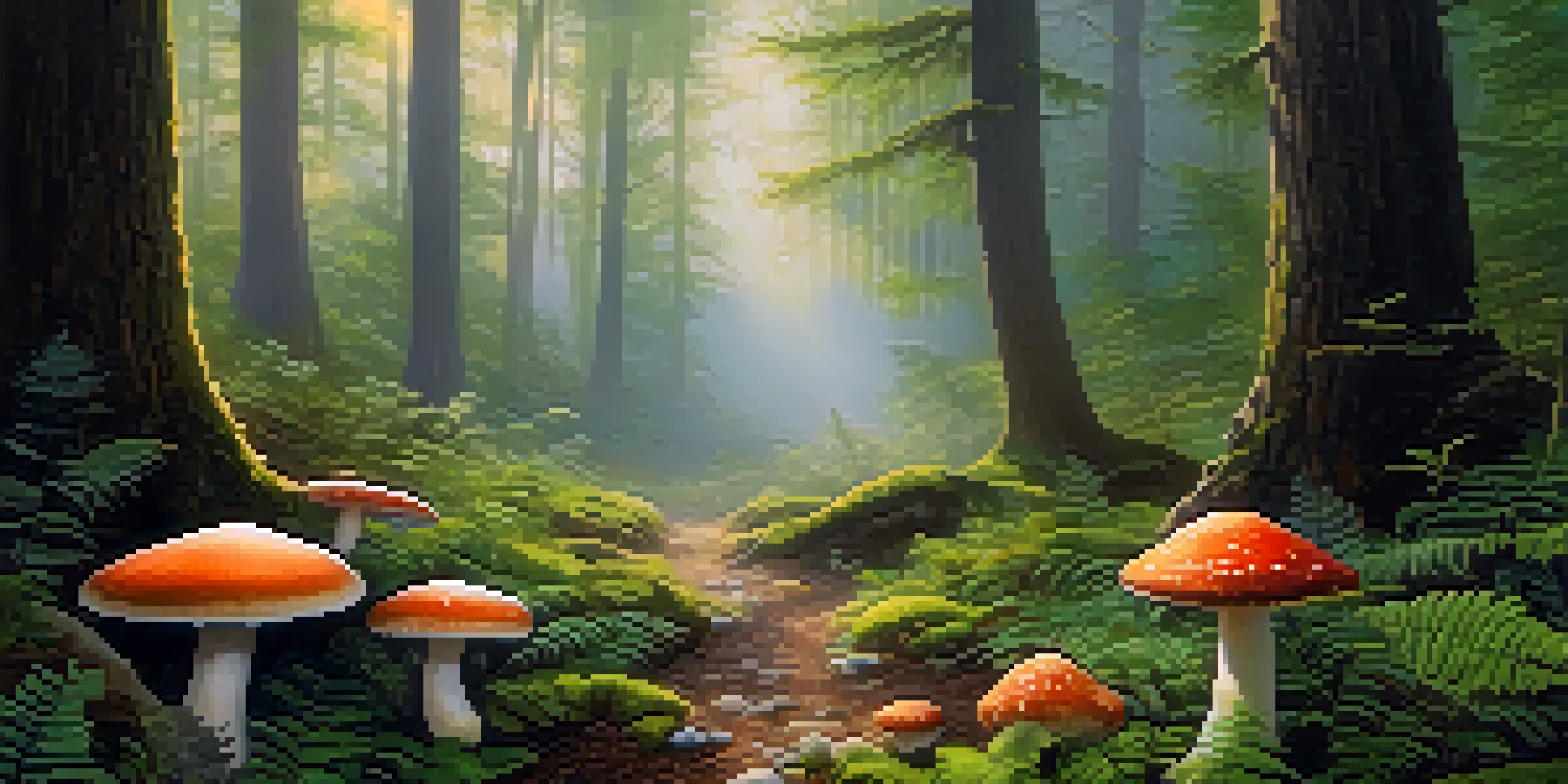Entheogens in Literature: Heroes and Their Transformations

Understanding Entheogens: A Brief Overview
Entheogens are substances that inspire spiritual or mystical experiences, often derived from plants or fungi. These natural compounds have been used for centuries in various cultures for religious and healing purposes. In literature, they serve as powerful catalysts for character transformation, enabling heroes to transcend their limitations and embark on profound journeys. By exploring the depths of consciousness, characters can discover new perspectives and insights.
The experience of the sacred is often a catalyst for transformation, a way to expand consciousness beyond the confines of the self.
The term 'entheogen' itself comes from the Greek words 'entheos,' meaning 'full of the god,' and 'genesthai,' meaning 'to generate.' This highlights the essence of these substances as tools for spiritual awakening. Many authors use entheogens as symbols or plot devices to indicate a shift in a character's journey, reflecting broader themes of growth and enlightenment.
From ancient texts to modern novels, entheogens hold a unique place in storytelling. They often represent the bridge between the ordinary and the extraordinary, pushing heroes to confront their inner demons and societal challenges. As we delve deeper into literary examples, we can see how these substances influence character arcs and thematic depth.
Entheogens as Catalysts for Change
In many literary narratives, entheogens act as catalysts for significant change in heroes. They provide moments of clarity, allowing characters to confront their fears and embrace their true selves. For instance, in Hermann Hesse's 'Steppenwolf,' the protagonist undergoes a transformative experience through the use of a hallucinogenic substance, leading to profound self-discovery and acceptance.

These experiences often lead to an expanded perception of reality, helping characters realize their interconnectedness with the world around them. This realization can be a turning point in their journey, prompting them to take action or make crucial decisions that reshape their destinies. Such transformations are not just personal but often resonate with wider social or moral themes.
Entheogens Inspire Transformation
Entheogens serve as powerful catalysts for personal growth and self-discovery in literary narratives.
Moreover, the use of entheogens can symbolize the struggle between society's norms and the individual's quest for authenticity. As heroes navigate their journeys, these substances illuminate the path toward self-liberation, challenging traditional beliefs and encouraging readers to question their own perceptions.
Literary Examples: Entheogens in Action
One of the most iconic examples of entheogens in literature is found in 'Alice's Adventures in Wonderland' by Lewis Carroll. Alice's journey through a fantastical landscape echoes themes of altered consciousness and identity exploration, reminiscent of entheogenic experiences. The bizarre characters and surreal scenarios she encounters reflect her internal transformation and growing understanding of herself.
It is through the journey into the depths of our own consciousness that we find the keys to our own liberation.
Similarly, in 'The Doors of Perception' by Aldous Huxley, the author shares his own experiences with mescaline, offering insights into perception and reality. Huxley's reflections serve as a narrative that intertwines philosophy and personal transformation, illustrating how entheogens can expand our understanding of existence. This blending of personal narrative with broader existential questions resonates deeply with readers.
These examples demonstrate how entheogens can serve as powerful literary devices, allowing authors to delve into the complexities of the human experience. Through these narratives, readers are invited to explore the multifaceted nature of consciousness and the potential for transformation inherent in each of us.
The Hero's Journey: A Transformative Framework
The Hero's Journey, a concept popularized by Joseph Campbell, outlines a universal pattern that many protagonists follow. Within this framework, entheogens often play a critical role in the 'Abyss' or 'Rebirth' stages, where heroes confront their deepest fears and emerge transformed. This pivotal moment often aligns with the use of entheogens, symbolizing a breakthrough that leads to renewal and clarity.
By engaging with these substances, heroes frequently gain insights that propel them toward their ultimate goal. This transformation is not merely external; it often leads to profound internal shifts that redefine their identities and purposes. As characters navigate through trials, the integration of these experiences becomes crucial for their growth.
Cultural Perspectives Matter
Different cultural views on entheogens enrich literary interpretations, reflecting diverse attitudes towards spirituality and consciousness.
The interplay between entheogens and the Hero's Journey highlights the transformative power of these substances. They serve as reminders that true heroism often involves facing one's inner struggles and emerging stronger on the other side, embodying the lessons learned in the process.
Cultural Perspectives on Entheogens in Literature
Different cultures have varying perspectives on entheogens, and this rich tapestry adds depth to literary interpretations. Indigenous cultures, for instance, often view these substances as sacred tools for healing and connection with the divine. In literature, authors draw from these cultural contexts to explore themes of spirituality and the human experience, enriching their narratives with diverse insights.
In contrast, Western literature often grapples with the tension between the mystical and the mundane, portraying entheogens as both transformative and potentially dangerous. This duality reflects societal attitudes towards substances that alter consciousness, revealing underlying fears and biases. Authors like Ken Kesey in 'One Flew Over the Cuckoo's Nest' highlight this struggle, showcasing the conflict between individuality and conformity.
Such cultural perspectives not only enhance the narrative but also invite readers to reflect on their own beliefs and experiences with entheogens. By weaving together different viewpoints, literature becomes a space for dialogue and exploration, encouraging a broader understanding of the complex relationship between humanity and these powerful substances.
Ethical Considerations in Depicting Entheogens
As entheogens continue to gain popularity in contemporary society, ethical considerations surrounding their depiction in literature become increasingly important. Writers must navigate the fine line between romanticizing these substances and addressing their potential risks and benefits. Responsible portrayals can foster understanding and openness, while sensationalism may perpetuate stigma and misinformation.
Authors should also consider the implications of cultural appropriation when drawing from indigenous practices and beliefs surrounding entheogens. Respecting the cultural significance of these substances is crucial to ensure that their portrayal honors the traditions and experiences of those who have used them for centuries. This awareness can lead to richer, more authentic narratives.
Ethics in Depicting Entheogens
Writers must approach the portrayal of entheogens with sensitivity to avoid romanticizing their use and respect cultural significance.
Ultimately, literature has the power to shape perceptions and influence public discourse about entheogens. By approaching these topics with sensitivity and nuance, writers can contribute to a more informed conversation about the role of entheogens in both personal and societal transformation.
Conclusion: The Lasting Impact of Entheogens in Literature
Entheogens have left an indelible mark on literature, serving as powerful symbols of transformation and self-discovery. Through the journeys of heroes, readers are reminded of the potential for growth that lies within each of us. As we explore these narratives, we gain insights into the complexities of the human experience and the ways in which entheogens can catalyze change.
The stories we encounter not only entertain but also challenge us to reflect on our own perceptions and beliefs. As we navigate our journeys, we may find parallels with literary heroes who have faced their own trials, often aided by the wisdom of entheogens. These narratives encourage us to embrace our own transformations, fostering a deeper understanding of ourselves and the world around us.

As literature continues to evolve, the themes of transformation, spirituality, and consciousness will undoubtedly remain relevant. By engaging with these ideas, we can foster a greater appreciation for the complexities of life and the transformative power of both literature and entheogens.